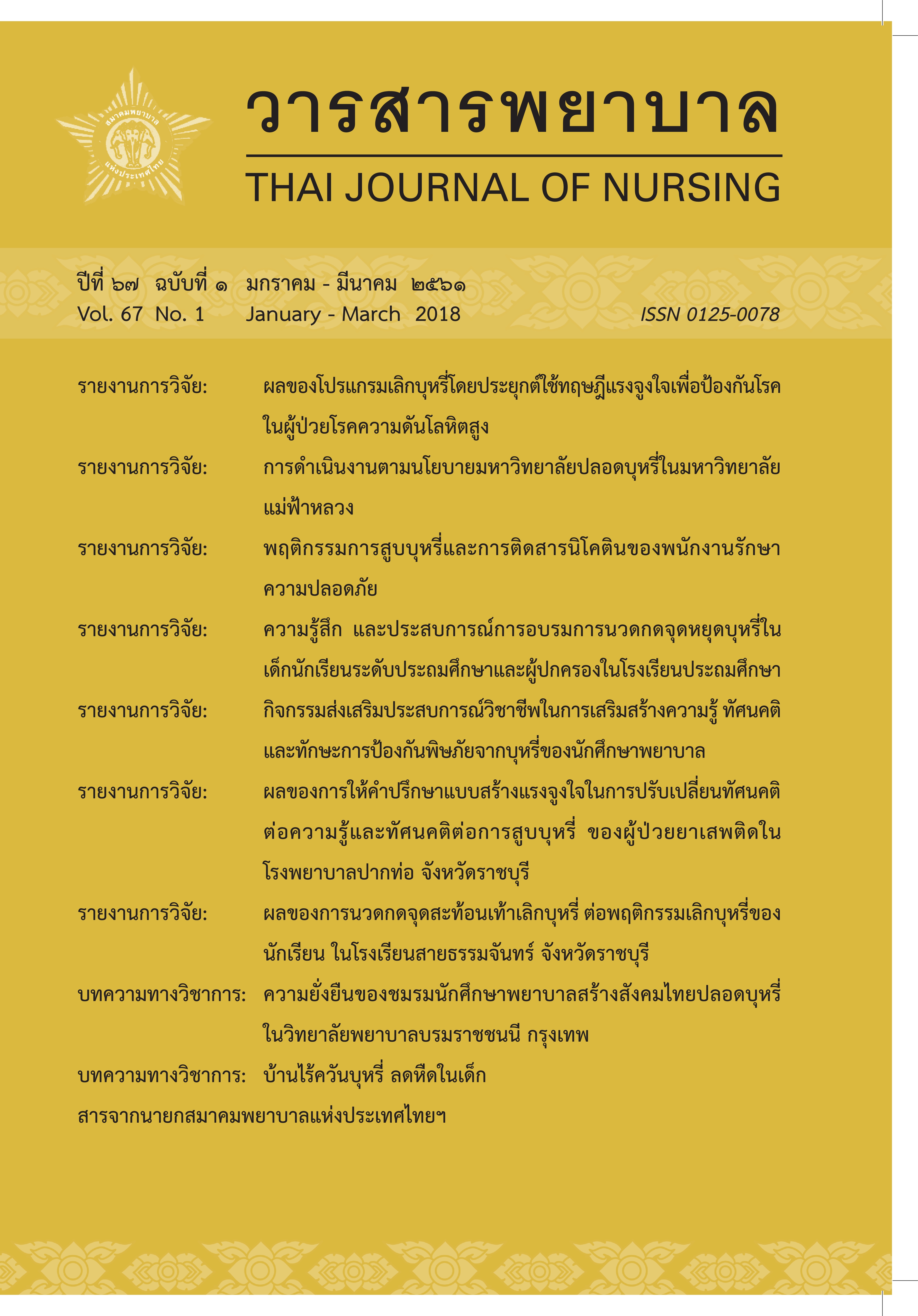Smoking behavior and nicotine addiction among security guards
Main Article Content
Abstract
The objectives of this descriptive research were to study smoking behaviors, nicotine addiction of security guards at Naresuan University, and to compare nicotine addiction between the regular and occasional smokers. The samples of 133 security guards working at Naresuan University, was systematic randomly selected. The research instrument was a questionnaire on smoking behavior and Fargerstrom nicotine dependence. The content validity index of smoking behavior questionnaire was 0.95. The Cronbach’s alpha coefficient of the nicotine dependence questionnaire was 0.80. Data were analyzed by descriptive statistics and Fisher’s exact test. The result revealed that security guards were regular smoker (43.61%) occasional smoker (9.77 %) and ex-smoker (at least a year ago) (14.28 %). The percentage of smokers who had nicotine addiction at the low-level, medium-level, and high-level, were 77.47, 16.90, and 5.63 respectively. There were no statistically significant differences in nicotine addiction between the regular and occasional smokers at p > .05.
Article Details
References
มณปรียากราฟฟิค.
กรองจิต วาทีสาธกกิจ. (2551). การส่งเสริมการเลิกบุหรี่ในงานประจำ (Smoking cessation in daily work).
กรุงเทพมหานคร: มูลนิธิรณรงค์เพื่อการไม่สูบบุหรี่.
กระทรวงสาธารณสุข. (2553). พระราชบัญญัติคุ้มครองสุขภาพผู้ไม่สูบบุหรี่ พ.ศ. 2553. นนทบุรี: ผู้แต่ง.
เบญจมาส บุณยะวัน, วันเพ็ญ แก้วปาน, สุรินธร กลัมพากร และนันทวัช สิทธิรักษ์. (2555). ประสิทธิผลของ
การประยุกต์ทฤษฎีขั้นตอนการเปลี่ยนแปลงพฤติกรรมในการเลิกสูบบุหรี่ของเจ้าหน้าที่รักษาความ
ปลอดภัย โรงพยาบาลศิริราช. ค้นเมื่อวันที่ 30 ตุลาคม 2560, จาก https://nosmoking.mahidol.
ac.th/content/document/5research.pdf
บุบผา จันมูล, อาทิตยา พรชัยเกตุ, โอว ยอง และประภา ยุทธไตร. (2556). การบำบัดแบบกระชับเพื่อหยุด
พฤติกรรมการสูบบุหรี่ในวัยผู้ใหญ่: การพยาบาลตามหลักฐานเชิงประจักษ์. วารสารพยาบาลสาธารณสุข,
27(1), 61-73.
ประภาพร นันทการัตน์. (2552). การศึกษาพฤติกรรมการสูบบุหรี่ของนักศึกษามหาวิทยาลัยเทคโนโลยีราช
มงคลกรุงเทพ. ค้นเมื่อวันที่ 15 กันยายน 2560, จาก https://tdc.thailis.or.th/tdc/dccheck.php
พิราสินี แซ่จ่อง. (2552). พฤติกรรม เงื่อนไข ผลกระทบต่อผู้ที่สามารถเลิกสูบบุหรี่ได้และผู้ที่ไม่สามารถเลิก
สูบบุหรี่ได้ในตำบลพะตง อำเภอหาดใหญ่ จังหวัดสงขลา. ค้นเมื่อวันที่ 15 กันยายน 2560,
จาก https://kb.psu.ac.th/psukb/bitstream/2010/5912/1/307655.pdf
ลักษณาพร กรุงไกรเพชร และกิตติ กรุงไกรเพชร. (2560). ปัจจัยที่มีผลต่อการสูบบุหรี่ของนิสิตมหาวิทยาลัย
บูรพา. ค้นเมื่อวันที่ 15 กันยายน 2560, จาก https://goo.gl/PuqNqW
สุเทพ ทักษิณาเจนกิจ. (2550). การศึกษาอัตราการติดสารนิโคตินและพฤติกรรมการสูบบุหรี่ของประชากร
ที่ร่วมโครงการลด ละ เลิก บุหรี่ถวายราชินี 72 พรรษา ในจังหวัดขอนแก่น. ค้นเมื่อวันที่ 5 กันยายน
2560, จาก https://www.trc.or.th/trcresearch/subpage/RS/TC_2550_48.pdf
สำนักควบคุมการบริโภคยาสูบ และศูนย์วิจัยและจัดการความรู้เพื่อการควบคุมยาสูบ. (2559). สถานการณ์
การควบคุมการบริโภคยาสูบของประเทศไทย พ.ศ. 2559. กรุงเทพมหานคร: เจริญดีมั่นคงการพิมพ์.
สำนักควบคุมบริโภคยาสูบ. (2559). แผนยุทธศาสตร์การควบคุมยาสูบแห่งชาติ พ.ศ. 2559-2562. นนทบุรี:
ไนซ์เอิร์ธ ดีไซน์.
สำนักงานสถิติแห่งชาติ. (2558). สรุปผลที่สำคัญ การสำรวจพฤติกรรมการสูบบุหรี่และการดื่มสุราของ
ประชากร พ.ศ. 2557. กรุงเทพมหานคร: ผู้แต่ง.
Fargerstrom, K., & Schnieder, N. G. (1989). Measuring nicotine dependence: A review of the
Fagerstrom Tolerance Questionnaire. Journal of Behavioral Medicine, 12(2), 159-182.
Tomkins, S. S. (1996). Psychological model for smoking behavior. American Journal of Public
Health, 56(12), 17-20.
Yamane, T. (1973). Statistics: An introduction analysis (2 nd ed.). New York: Harper & Row.


